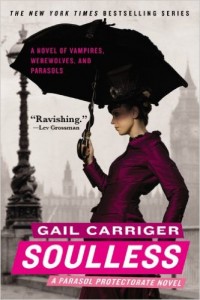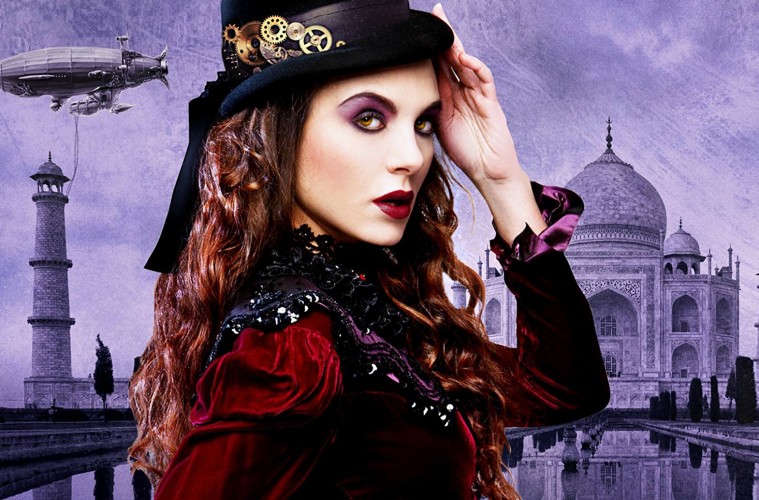The first time I tried to describe The Parasol Protectorate, Gail Carriger’s first series and the origins of her now expansive world, I mostly came up with a string of words: Steampunk-werewolf-vampire-Victorian-romance-fantasy-science. There were so many things going on—things that I loved—that I didn’t even know where to begin.
 Now, two years on, I think I can articulate it a bit better. Carriger’s books—all of which take place in the same fabulous world—now include not only the five-part Parasol Protectorate (and its manga adaptation), but also the four-part Finishing School series (aimed at more of a YA audience) and The Custard Protocol, a duology whose second volume is due out in July. And while they are indeed Victorian-set steampunk fantasies with vampires and werewolves aplenty, they also showcase Carriger’s love for period research and strange technologies. Here’s a few of the things that kept me reading:
Now, two years on, I think I can articulate it a bit better. Carriger’s books—all of which take place in the same fabulous world—now include not only the five-part Parasol Protectorate (and its manga adaptation), but also the four-part Finishing School series (aimed at more of a YA audience) and The Custard Protocol, a duology whose second volume is due out in July. And while they are indeed Victorian-set steampunk fantasies with vampires and werewolves aplenty, they also showcase Carriger’s love for period research and strange technologies. Here’s a few of the things that kept me reading:
How Much Soul? In Carriger’s world, vampires and werewolves—and ghosts—aren’t the products of magic or some unidentifiable source. No, it’s all about how much soul you have. Too little and you probably won’t survive the bite. For this reason, the supernatural set tends to gravitate towards artists, meaning that the cast of characters is full of goofy artist types who provide plenty of entertainment. There are also plenty of scientists (nefarious and otherwise) doing their best to figure out exactly how much soul it takes for one to join the supernatural set.
A Comedy of Manners It’s the Victorian Era, so manners reign as much as Queen  Victoria does. The Finishing School series is all about manipulating manners and social norms to help the students/assassins-in-training achieve their ends. In the Parasol Protectorate, the protagonist, Alexia Tarabotti has, unlike most humans, no soul at all, rendering her extremely pragmatic and rather attached to proper conduct. Pitting her against Lord Maccon, a Scottish alpha werewolf with pretty much no concept of manners at all, causes sparks (both infuriated and romantic) to fly.
Victoria does. The Finishing School series is all about manipulating manners and social norms to help the students/assassins-in-training achieve their ends. In the Parasol Protectorate, the protagonist, Alexia Tarabotti has, unlike most humans, no soul at all, rendering her extremely pragmatic and rather attached to proper conduct. Pitting her against Lord Maccon, a Scottish alpha werewolf with pretty much no concept of manners at all, causes sparks (both infuriated and romantic) to fly.
So Much Sass Carriger excels at a lot of things as a writer, but above all, her writing is entertaining. Her characters are witty and sarcastic, even ridiculous, and always at the right moments. The narration, too, has plenty of sass, and more than once, I’ve had to stop reading to text a friend a hilarious line or two with absolutely no context. These are fun books that are easy to get through and bring a smile to the reader’s face.
Emotional Investment Well, okay, they’re fun until they rip your heart out with devastating reveals about your favorite characters’ pasts that leave you stunned and full of, as Tumblr might put it, Feels. Everything is fun and games until your faves are disgraced, miserable, and parted from the people they love.
Excellent Ladies These books are populated by big personalities and, sure, some of the flashiest characters in these books are men (and I really do mean flashy, particularly in the case of Lord Ackeldama, a monocle-wearing vampire with a penchant for brightly colored silks and gold leaf). But the real gems here are the women. Carriger’s ladies are strong, silly, bitchy, heroic, adventurous, grumpy, flirtatious, gay, straight, skinny, pudgy, and everything else in between. At a time when we’re all (sadly) still looking for diverse and wonderful women to read, Carriger has no trouble creating characters who fill the void.
I could keep going. But what it boils down to is that Gail Carriger’s books make for an entertaining, engaging, immersive, emotional reading experience. The steampunk and fantasy elements allow for some good, old-fashioned escapism, but the storylines are all about human nature. Oh, and sometimes they’re a little smutty. Should I have mentioned that earlier?
Images via Amazon


